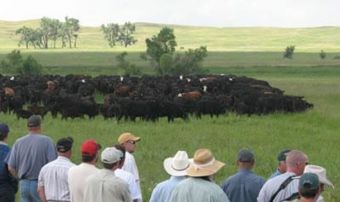Difference between revisions of "Food/Sustainable ranching"
m (typo) |
m (typo) |
||
| Line 1: | Line 1: | ||
| − | [[Image:Mob_grazing.jpg|thumb|340px|right|Mob-grazing in action. Note that the cattle are clustered tightly together, not scattered like on extensive pastures. This is necessary for the grass and soil to benefit. The farm in the picture is also using silvopasture - growing trees on pasture. The leaves provide extra feed for the livestock, and can also produce fruit, nuts or timber.]]Ranching is often blamed for environmental problems <sup>[http://www.fao.org/newsroom/en/news/2006/1000448/index.html][http://www.bae.ncsu.edu/programs/extension/manure/cattle/cattleprod/]</sup> because it uses water, can require large amounts of grain feed, antibiotics which leach into the environment and can pollute local water supplies with runoff. While these points are valid, there is a way of raising livestock that is more in harmony with nature, while also being much more productive than either feedlots or extensive grazing. It is called mob-grazing or cell-grazing and works by imitating the natural grazing patterns of herbivores. | + | [[Image:Mob_grazing.jpg|thumb|340px|right|Mob-grazing in action. Note that the cattle are clustered tightly together, not scattered like on extensive pastures. This is necessary for the grass and soil to benefit. The farm in the picture is also using silvopasture - growing trees on pasture. The leaves provide extra feed for the livestock, and the trees can also produce fruit, nuts or timber.]]Ranching is often blamed for environmental problems <sup>[http://www.fao.org/newsroom/en/news/2006/1000448/index.html][http://www.bae.ncsu.edu/programs/extension/manure/cattle/cattleprod/]</sup> because it uses water, can require large amounts of grain feed, antibiotics which leach into the environment and can pollute local water supplies with runoff. While these points are valid, there is a way of raising livestock that is more in harmony with nature, while also being much more productive than either feedlots or extensive grazing. It is called mob-grazing or cell-grazing and works by imitating the natural grazing patterns of herbivores. |
Herbivores in the wild huddle close together for protection from predators. In this 'mob', they mow down an area of grass in about a day, then move on to a different patch. Ranches can be managed so that the livestock graze in this pattern. Using light, portable electric fencing, livestock can be corralled into a small 'cell' of grass at very high densities. Each day, the herd is moved to a different 'cell' of grass, so that each cell of grass is only grazed a few days per year. | Herbivores in the wild huddle close together for protection from predators. In this 'mob', they mow down an area of grass in about a day, then move on to a different patch. Ranches can be managed so that the livestock graze in this pattern. Using light, portable electric fencing, livestock can be corralled into a small 'cell' of grass at very high densities. Each day, the herd is moved to a different 'cell' of grass, so that each cell of grass is only grazed a few days per year. | ||
Revision as of 23:56, 19 June 2011

Herbivores in the wild huddle close together for protection from predators. In this 'mob', they mow down an area of grass in about a day, then move on to a different patch. Ranches can be managed so that the livestock graze in this pattern. Using light, portable electric fencing, livestock can be corralled into a small 'cell' of grass at very high densities. Each day, the herd is moved to a different 'cell' of grass, so that each cell of grass is only grazed a few days per year.
The effects of this sort of grazing are remarkable, both for the grasslands and the animals. The manure fertilizes the grass, the mowing causes the grass to shed some of its roots, which then decompose and further improve the soil, and the animals' hooves break up the hardpan on the surface, further improving the structure of the soil. See water-efficient agriculture for how effective this is at helping soil hold moisture. This is particularly needed in sub-Saharan Africa, where extensive grazing patterns have made grasslands dry and dead. In areas of sub-Saharan Africa where cell-grazing has been implemented, grasslands have recovered and the soil and ecosystem holds so much water that drought is no longer a threat[3].
Another key advantage is that multiple animals can graze the same pasture in rotation. Polyface Farms grazes cows, turkeys, pigs, chickens, hens and rabbits on the same space by rotating them in time. This further benefits the soil and allows the animals to benefit from one another. For example, the maggots that grow in cow manure are a food source for chickens. Moreover, it obviously allows much higher productivity per unit of land.